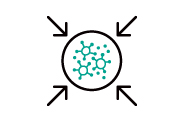The EU GMP Annex 1 guideline outlines, covering various aspects of aseptic processing, including personnel, premises, equipment, production, and specific technologies.
Maintaining a sterile environment is crucial in medicinal product manufacturing, necessitating strict adherence to guidelines and standards to minimize contamination risks and ensure product quality and safety.
In this article, we will delve into Ansell's aseptic donning method, a recommended approach to minimize contamination during the gowning process and maintain the integrity of products produced in aseptic environments.
Understanding the EU GMP Annex 1: Aseptic Processing
The EU GMP Annex 1 guideline is a comprehensive guide for manufacturing sterile medicinal products, encompassing design, validation, operation, and control of aseptic processing facilities, personnel training and qualification, environmental monitoring, cleaning, and disinfection. The goal of the guideline is to ensure sterile products are free from microbial or particulate contamination and meet their quality specifications. The new version of Annex 1, published on 25th August 2022, will be implemented on 25th August 2023. The updated guideline emphasizes the principles of quality risk management and contamination control strategy throughout the aseptic process and its techniques.
Aseptic Donning: A Critical Step in Sterile Environments
Aseptic donning is a vital step in maintaining a sterile environment. It involves using Personal Protective Equipment (PPE) products to minimize contamination risks during the gowning process. Aseptic donning of cleanroom coveralls is particularly important for maintaining the quality and safety of products manufactured in aseptic processing environments. Adhering to specific protocols is necessary, including donning cleanroom gloves, masks, and goggles to avoid contaminating the outer surface of cleanroom PPE products, maintaining the integrity and safety of products and cleanroom environments.
Ansell's Aseptic Donning Method
Ansell's aseptic donning method for cleanroom coveralls is a recommended approach to minimize contamination during the gowning process. Ansell's donning guides, available in static and video formats, show how to don cleanroom coveralls according to strict guidelines stipulated in Annex 1. Operators are only allowed to touch the inner surface of the cleanroom coverall when donning.
Watch our video guide for the BioClean-D™ Coverall with Collar (S-BDCCT) to understand the steps involved in maintaining a sterile environment during the donning process.
Our video here showcases Ansell's innovative garment fold technique that enables true aseptic donning, enhancing your cleanroom safety and efficiency. For more detailed guides, check out our other donning videos: BioClean-D™ Coverall with Hood and Integrated Boots S-BDFC and BioClean-D™ Sterile Coverall with Hood S-BDCHT
Ansell's donning method ensures that particulate contamination is prevented before entering cleanroom environments. By rolling up the coveralls to shorten their length, operators provide a better grip for easier donning, and the foot section of the coverall does not touch the floor when operators insert their legs into the pant/trousers part of the coverall. This method and the way Ansell cleanroom coveralls are packed minimize cross-contamination, protecting operators, and maintaining the integrity of products.
The steps to Ansell's aseptic donning method for coveralls are as follows:
- Remove the coverall from the package. The coverall is unzipped, and the chest inverted around the sleeves and legs which have been folded in a specific way to ensure they do not unfold and touch the floor whilst donning
- Hold the coverall at the waist, which will be the interior, hold in front of you to prepare for donning
- Optionally, roll the coverall at the waist slightly to shorten the length and provide a better grip for easier donning
- While holding the interior at the waist, carefully insert each leg into the pant/trousers one at a time
- Once legs are fully donned, insert the hand carefully into one sleeve while the other hand maintains grip at the waist. Once one arm is donned insert the other hand into the other sleeve
- Once both hands are inserted into the sleeves, raise both hands up above your head to fully stretch out the garment
- To don the hood, reach behind your head with palms facing each other, insert hands inside the hood, and bring the hood up and over the head
- Cross your legs, hold the zipper, and pull upwards until the coverall is fully zipped up
- After zipping up the coverall, it is important to transfer the leg to the cleaner part of the changing room (white zone) after putting on the overboot. In the industry, a "grey zone" is typically used to denote the preparation area, which is not as clean as the "white zone." This is a crucial step in maintaining a sterile environment and is practiced by all pharmaceutical companies. Physical segregation using a bench or bund is often used to clearly separate the two zones.
- Coverall donning complete.
Benefits of Ansell's Aseptic Donning Method
Ansell's aseptic donning method offers several advantages to the pharmaceutical industry, including:

Minimizing contamination |

Easy to follow |

Maintaining product integrity |
An Overview of Ansell's Protective Clothing Range
Ansell offers a comprehensive line of protective clothing specifically designed to meet the diverse needs of cleanroom environments. These products are engineered to provide reliable protection, exceptional comfort, and ease of use. All coveralls in the BioClean-D™ series features an innovative material, making them lightweight and low-linting. The construction of these garments includes bound seams with single stitching. Here is a brief overview of Ansell's BioClean-D™ cleanroom coveralls:
- BioClean-D™ S-BDCCT: This sterile coverall features a high neck collar that needs to be worn with a hood and Overboots.
- BioClean-D™ S-BDFC: This sterile coverall with hood features integrated boots with slip-resistant soles, for added workplace safety.
- BioClean-D™ S-BDCHT: This sterile coverall is designed with an integrated hood that needs to be worn with overboots.
- BioClean-D™ Drop-down Sterile Garment with Hood S-BDSH: This sterile coverall boasts drop-down design technology, preventing needless external surface contact, and is equipped with quick-release tabs and internal colored tabs, indicating safe touch points that further ensure aseptic donning.
These coveralls are just a few examples of the extensive range of protective clothing offered by Ansell, designed to cater to a variety of needs in the pharmaceutical and medical device industries. By combining their high-quality protective clothing with the aseptic donning method, operators can maintain a sterile environment and ensure the safety and efficacy of pharmaceutical products. To learn more about Ansell's protective clothing line, visit our page here.
Ansell's Cleanroom Coverall Packaging
Ansell's sterile PPE is double or triple-bagged in durable plastic packaging to reduce contamination, and sterilization indicators show that the PPE has been sterilized to a Sterility Assurance Level (SAL) 10-6. Certificates of Irradiation (Gamma irradiation sterilization) or Certificates of Processing (Ethylene oxide sterilization) per product lot number can be downloaded via Ansell's easy-to-use certificate tool on www.ansell.com/life-sciences/certificates to prove the PPE has undergone the full sterilization process.
Conclusion
Ensuring a sterile environment is critical to prevent contamination and maintain product quality and safety. The EU GMP Annex 1 guideline provides stringent requirements for aseptic processing, including proper gowning guidelines. By following the Annex 1 guidelines and utilizing Ansell's cleanroom coveralls and packaging, operators can maintain a sterile environment and uphold the safety and efficacy of pharmaceutical products. Ansell's aseptic donning method is a recommended approach to minimize contamination during the gowning process, providing several benefits to the industry, including minimizing contamination, being easy to follow, and maintaining product integrity.
| SUBSCRIBE TO CRITICAL INSIGHT | GET IN TOUCH |



